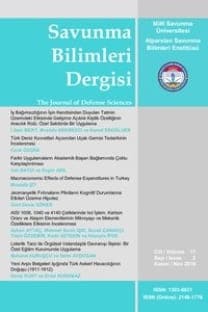Savunma Sanayisinde Aşırı Koşullara Maruz Kalan Hafif Yapısal Malzemelerin Yüzey Modifikasyonu
Bu çalışmada, alüminyum oksit, silisyum oksit, wolfram-titanyum karbür ve titanyum karbür parçacıklar ilave edilerek hazırlanan çözeltilerde, plazma elektrolitik oksidasyon (PEO) yöntemiyle AA7075 alaşımı üzerine seramik kaplamalar geliştirilmiştir. Kaplamaların faz bileşimi x-ışını kırınımı (XRD) yöntemiyle incelenmiştir. Taramalı elektron mikroskobu (SEM) ile kaplamaların yüzey morfolojisi ve kesitin mikroyapısı incelenmiştir. Enerji dağılımlı x-ışını spektrometresi (EDX) sayesinde kaplamaların kimyasal analizi yapılmıştır. Kaplamaların sertlik değerleri mikroVickers sertlik test cihazıyla ölçülmüştür. Kaplama yapılan altlık alaşımların sürtünme ve aşınma davranışını incelemek amacıyla 100Cr6 çelik ve alüminyum oksit bilyelere karşı kuru kaymalı aşınma testleri yapılmıştır. Aşınma testi sonrası yüzey profilometresiyle aşınma profili çıkarılarak aşınan malzeme hacmi hesaplanmıştır. Yapılan testler sonucunda AA7075 alaşımın yüzey sertliği ve aşınma dayanımının üretilen PEO kaplamalarla önemli ölçüde arttığı gözlenmiştir. Kaplamalar yoğun iç tabaka ve gözenekli üst tabakadan oluşmaktadır. Kaplama sertliğinin altlık/kaplama arayüzeyine yakın bölgede yüksek, yüzeye doğru ilerledikçe gözenekliliğin artışından dolayı düştüğü belirlenmiştir. Silisyum oksit parçacık içeren çözeltilerde üretilen kaplamaların diğer kaplamalara göre daha kalın ve pürüzlü olduğu tespit edilmiştir. En düşük aşınma kaybı titanyum karbür içeren çözeltilerde üretilen kaplamada elde edilmiştir.
Anahtar Kelimeler:
AA7075, Plazma Elektrolitik Oksidasyon, Nanoparçacık, Sertlik, Aşınma
Surface Modification of Light Alloys Exposed to Excessive Conditions in the Defense Industry
In this study, ceramic coatings were developed on AA7075 alloy by plasma electrolytic oxidation (PEO) method in different solutions prepared by adding aluminum oxide, silicon oxide, wolfram-titanium carbide and titanium carbide particles. The phase composition of the coatings was investigated by x-ray diffraction (XRD) method. The surface morphology of the coatings and the microstructure of the cross-section were investigated by scanning electron microscopy (SEM). Chemical analyzes of the coatings were made by means of energy distribution x-ray spectrometry (EDX). The hardness values of the coatings were measured by microVickers hardness tester. In order to examine the friction and wear behavior of the coated substrates, dry sliding wear tests were performed against 100Cr6 steel and alumina balls. After the wear test, the wear profile was obtained by the surface profilometer and the material volume loss was calculated. As a result of the tests, it has been observed that the surface hardness and wear resistance of the AA7075 alloy was significantly increased by the application of PEO coatings. The coatings consist of a dense inner layer and a porous outer layer. It has been determined that the coating hardness increased close to substrate/coating interface while decreasing towards the free surface due to the increased porosity. The coatings produced in silicon oxide particle-containing solutions were found to be thicker and rougher than the other coatings. The lowest wear loss was obtained in the coating produced in titanium-carbide-containing solutions.
Keywords:
AA7075, Plasma Electrolytic Oxidation, Nanoparticle, Hardness, Wear,
___
- Kitaplar
- Davis, J.R. (1993). Aluminum and Aluminum Alloys. Cleveland: ASM International. McColm, I. (1990). Ceramic Hardness. New York: Springer US.
- Makaleler
- Arunnellaiappan, T., Arun, S., Hariprasad, S., Gowtham, S., Ravisankar, B., Rama Krishna, L., Rameshbabu, N. (2018). Fabrication of corrosion resistant hydrophobic ceramic nanocomposite coatings on PEO treated AA7075. Ceramics International, 44, 874–884. Fatimah, S., Kamil, M.P., Kwon, J.H., Kaseem, M., Ko,Y.G. (2017). Dual incorporation of SiO2 and ZrO2 nanoparticles into the oxide layer on 6061 Al alloy via plasma electrolytic oxidation: Coating structure and corrosion properties. Journal of Alloys and Compound, 707, 358-364. Kollenberg. W., Schneider, H. (1989). Microhardness of Mullite at Temperatures to 1000°. Journal of the American Ceramic Society, 72(9), 1739-1740. Krell, A., Schädlich, S. (2001). Nanoindentation hardness of submicrometer alumina ceramics. Materials Science and Engineering: A, 307(1–2), 172- 181. Lamouri, S., Hamidouche, M., Bouaouadja, N., Belhouchet, H., Garnier, V., Fantozzi, G., Trelkat, J.F. (2017). Control of the γ-alumina to α-alumina phase transformation for an optimized alumina densification, Boletín de la Sociedad Española de Cerámica y Vidrio, 56(2), 47-54. Nasiri Vatan, H., Adabi, M. (2017). Investigation of wear and corrosion resistance of nanocomposite coating formed on AZ31B Mg alloy by plasma electrolytic oxidation. The International Journal of Surface Engineering and Coatings, 95(6), 308-315. Necşulescu, D.A. (2011). The Effects of Corrosion on The Mechanical Properties of Aluminium Alloy 7075-T6. U.P.B. Sci. Bull. Series B, 73(1), 223-229. Pitchford, J.E., Stearn, R.J., Kelly, A., Clegg, W.J. (2004). Effect of Oxygen Vacancies on the Hot Hardness of Mullite. Journal of the American Ceramic Society, 84(5), 1167-1168. Shibe, V., Chawla, V. (2014). A Review of Surface Modification Techniques in Enhancing the Erosion Resistance of Engineering Components. International Journal of Research in Mechanical Engineering & Technology, 4,92-95. Xin, S., Song, L., Zhao, R., Hu, X. (2006) Composition and thermal properties of the coating containing mullite and alumina, Materials Chemistry and Physics, 97(1), 132-136. Yerokhin, A.L., Nie, X., Leyland, A., Matthews, A., Dowey, S.J. (1999). Plasma electrolysis for surface engineering. Surface and Coatings Technology, 122, 73–93.
- ISSN: 1303-6831
- Yayın Aralığı: Yılda 2 Sayı
- Başlangıç: 2002
- Yayıncı: Milli Savunma Üniversitesi Alparslan Savunma Bilimleri ve Millî Güvenlik Enstitüsü
Sayıdaki Diğer Makaleler
Biyomedikal Uygulamalar İçin TiN Kaplı Ti6Al4V Alaşımının Mekanik Özelliklerinin Araştırılması
Savunma Sanayisinde Aşırı Koşullara Maruz Kalan Hafif Yapısal Malzemelerin Yüzey Modifikasyonu
Hayrani ULUTÜRK, Uğur MALAYOĞLU, Kadir Cihan TEKİN
Hoş Geldin Kültüründen Popülizme
Rol Belirsizliğinin İş Tatmini ve İşten Ayrılma Üzerindeki Etkisi
Ali GÜRSOY, Kemal KÖKSAL, Hakan YAPAR
Stokastik Talepli Araç Rotalama Problemi İçin Literatür Taraması
Beste DESTİCİOĞLU, Bahar ÖZYÖRÜK
Uluslararası Çatışmaların Değişen Yapısında Terörün Yeri ve Önemi Üzerine Bir İnceleme
